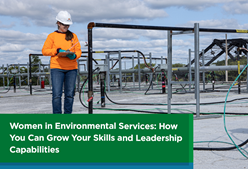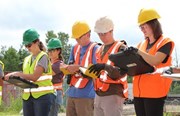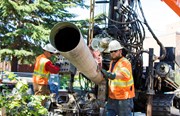Women in Environmental Services: Project Manager Patty Anaya
More and more women are discovering that a career in environmental services can be both challenging and rewarding, with opportunities to grow and to work in a field that makes a difference every day.
Our quarterly Women in Environmental Services blog series highlights the work of these women, what brought them to this industry, and what they’ve learned along the way as they built successful careers.
Today, we’d like to introduce you to Patty Anaya.
Meet Patty Anaya
 Patty Anaya is a Project Manager with Cascade’s drilling services team based in Southern California, and she is responsible for managing project progression from initial request for proposal through final billing.
Patty Anaya is a Project Manager with Cascade’s drilling services team based in Southern California, and she is responsible for managing project progression from initial request for proposal through final billing.
What career did you imagine for yourself as a child?
As a child, I thought I might want to be a teacher and work with kids.
What career did you plan to pursue when you began college?
After graduating from high school, I went straight to college to study marine biology. I was interested in the subject because I wanted to make a difference by helping the health of the ocean and therefore the planet, as the two go hand in hand. While in college, I worked for customer service at PacifiCare Medical, where I learned my way around an office environment.
How did you end up in your current role?
In 2007, I was in between jobs, and a temp agency placed me at Cascade’s La Habra, California office as the front desk receptionist. Little did I know that this temporary job assignment would become my career. At the time, I wasn’t familiar with the environmental services Cascade provided.
As I began learning, I became increasingly intrigued. This industry swallowed me in one bite! I knew this is where I wanted to be. Not only did I find camaraderie with my coworkers, but I saw that Cascade truly makes a difference in the world, and I was proud of that; it still makes me feel good today.
I enjoyed hearing the drillers talk about the lithology while drilling, and about troubleshooting how to drill and what specific method to use. I initially thought, “Just put a bit on the machine and drill, how hard can it be?” Boy, was I wrong! I remember asking my project manager if I could learn more. He took me on a field trip to three sites using different drilling methods and explained why they were being used.
Over time, I was promoted to office manager, with responsibility for Department of Transportation compliance, to project coordinator, and then to the role I have today, project manager. I report to the Senior Vice President of Operations.
What kind of things do you do in your current role?
As a project manager, I run sonic drilling projects, ranging in size from $600,000 to over $2,000,000, in the Southern California area. This role is “all-in-one,” meaning that I wear many hats! I am responsible for scheduling work with the client, crews and equipment. I set up tooling, material, rental equipment, and training for each job, and work with mechanics to repair, fabricate or service equipment. I’m highly involved in safety on site, conducting site audits and crew observations. I also handle all invoicing and help manage HR for employees on my team.
Since 2018, I’ve been responsible for running two ongoing sites at a major utility using sonic, dual rotary, air vac, auger, and development methods.
In sonic drilling, sonic frequencies rotate and vibrate the drill rod, core barrel, and casing at the same time. This method results in a clean borehole, and is used for both soft and hard formations, including dense clay, cobbles, boulders, and debris. Drilling with this method reduces investigation derived waste (IDW) 70%-80% more than drilling with a rotary or auger (IDW is the water, soil, and cuttings generated when you drill). Sonic can be used in combination with another tooling to collect geotechnical samples, core rock, and collect groundwater profile samples, to name a few.
Dual rotary (DR) is used for difficult formations. DR uses both upper and lower drives to advance the bit and casing. A studded shoe is welded to the first piece of casing, which helps cut through sand, gravel, and boulders.
Air vacuum rigs are used to pre-clear our drilling locations up to 10 feet below ground surface. This method uses compressed air to reduce the IDW onsite and vacuum to contain all cuttings as the hole is being cleared. Cascade participates in the golden shovel policy, which is a procedure to expose utility lines such as gas, electric, and water. This helps eliminate any damage/injury prior to drilling.
Auger is a method used for drilling in sands, silts, and clays.
Development is used to clean out the clays and silts prior to putting a well into service. It’s also used for well abandonments, pump installations, and well rehabilitation “acid treatments.” All of these approaches are used in combination at these ongoing California sites.
Obviously, I’ve learned a lot over the years!
What is your favorite part of this job? How about the environmental services industry?
My favorite part of this job is the problem solving. Every day, a new and different challenge is sent my way. For example, I had a project in Malibu. I needed to send the air knife rig (an excavation tool that uses high-pressure air to break up soil) to the site to pre-clear a location down to five feet. We followed policy and procedures by calling the local “811 ticket” (call before you dig) in advance so they pre-marked all utilities prior to arriving. Our crew arrived at the site, made sure they were aware of all the utilities pre-marked on the street, and began clearing the location.
The crew cleared to about two feet below ground surface when they encountered a four-inch steel line in their path that was not marked out. The crew immediately stopped work and called me. The client wanted them to cut this unmarked four-inch line and cap it, but I told the crew to stop, and I went to the site to speak to the client. I told the client that we could not risk cutting the unmarked and unknown pipe, and I had the crew pack up all equipment and remove themselves from the site.
It was the right thing to do for a host of reasons, especially safety. The pipe turned out to be an abandoned waterline, not accounted for on any city plans/map, but at that moment, we had no way of knowing that. I was proud of the crew and I was happy to show up and have their backs.
What traits and/or habits have helped make you successful?
I ask a lot of questions and always want to know how things work. I believe my persistence and drive to always do better are the keys to my success.
Were you provided with advice or mentorship along the way? If so, can you share how it helped?
Throughout my career here at Cascade, I have expressed my interest in wanting to learn everything I can. I had a manager that always encouraged me and helped me along the way. He gave me a shot and I ran with it and never looked back.
What would you tell other women considering a career in environmental services?
We all know this is a male-dominated industry, however, times are changing and I am proof that a career in environmental services is possible. Cascade is an equal opportunity company, and I’m thankful for that because they have given me many chances to learn and grow. My advice is to take those opportunities that come your way, work hard, and never give up!
What resources would you recommend to them?
Cascade hosted a webinar awhile back where women in our industry discussed the challenges they’ve faced in environmental services and how they overcame them. The recording is available to watch on demand, and is a great opportunity to see how others have handled their careers. You can watch it here.
There’s also a private Women in Environmental Services LinkedIn group to help women connect, learn and grow professionally. Those who are interested can request to join here.
Thanks to Patty for sharing her experience and insight with us!





